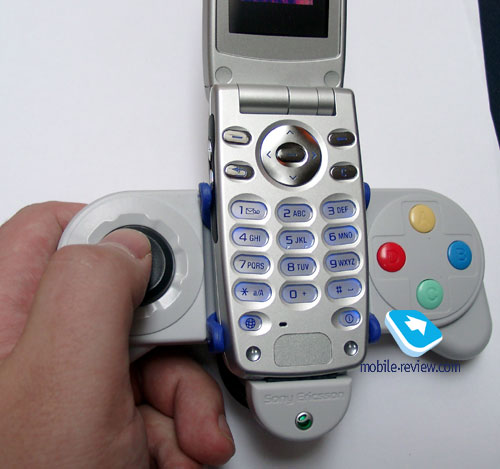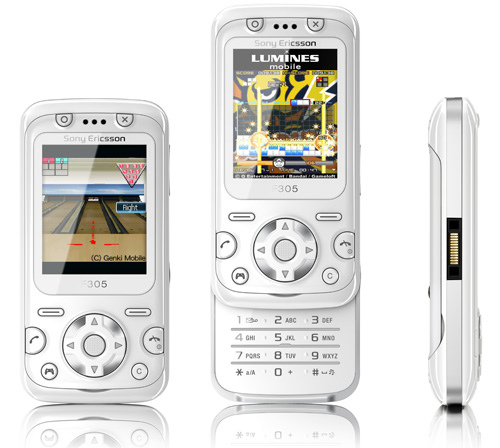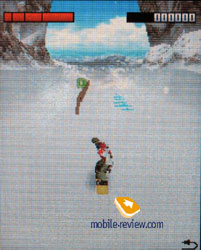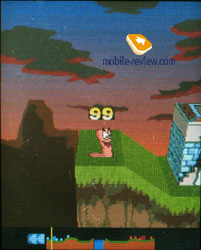|
|
Sony Ericsson vs Playstation
Mobile games still make a very sweet morsel of the market, especially when the target audience is teenagers, for whom this department has a significant weight. If there was one lesson to learn from the fiasco of the first iteration of NGage, it would be that mobile phones can't stand up to dedicated gaming consoles, and thus shouldn't attempt to foray into any genre but casual games.
Background and What's Going on?
Instead of sending you back to one of our previous pieces on the second iteration of the NGage service, we will rather use some snippets from that article here, which will allow us to save a lot of time.
The announcement of N-Gage platform in its second iteration has been anticipated since the end of 2006 - the company did nothing to disguise its plans. The Web has been buzzing with descriptions of gaming services, as well as the N-Gage application window, revamped animated logo and the lowdown on the concept itself. In fact, everything you needed to know about the N-Gage was available long before the official introduction. Occasionally the company would spark new waves of craze by proclaiming cooperation with some developers.
Why does the gaming market mean so much for mobile terminal manufactures today? Let's look at the major lines of development in the industry and see which niches still have no tough competition. Starting from 2004 the companies have been into music, with the birth of Walkman brand, this market made the statement, so now all top manufacturers are fighting for a chunk of the pie. The question of whether a music-minded handset can serve as a replacement for a stand-alone player has been decided in favor of handsets by many, which is quite an achievement already. Another guideline for mobile devices has been digital photography. This market emerged shortly before cameras made it to phones, which allowed them to develop at roughly equal pace. While first adopters had taken inbuilt cameras with a pinch of salt for their poor quality, they had nowhere to run when first 2 Mpix units with fairly good picture quality arrived. So these days, wherever you are, you can run into tourists using their handsets rather than digital compacts to take snaps.

МMusic and imaging are more of entertainment, and find little application in hands of enterprise users during their routine. At the same time, this audience vitally needs a bevy of connectivity options, mobile mail features, and ability to browse web resources. In today's mobile phones web-browsing is, well, the third most important constituent of a convergent device.
If you give the market of PC solutions a once-over and pay special attention to the youth, there will be another need - games. People like to keep themselves entertained, and video games are an integral part of this trend. So, why don't they bring this to mobile phones? The debut of the N-Gage wasn't all sunshine and rainbows - the manufacturer tried to come up with a stand-lone platform with closed standard of games, separate cartridges, which brought about the problem of logistics, manufacturing etc. It would have been much more interesting to see a standard platform and standard ways of software distribution. But back then the gaming experience was held back by display quality and sound performance of handsets - during the time span separating the two iterations of the N-Gage, the multimedia department of smartphones has evolved, so now they can make a good gaming platform. The market is also going through the peak of gaming consoles popularity (such as the Sony PSP). Which means the everything is now ready for the advent of a gaming platform crossed with a handset. Nokia has picked the right moment to present the N-Gage's second edition, with all factors producing synergy effect. The users already have the experience of using their phones in ways different from the original purpose of the phone to, so this will be nothing new to them.
What companies pioneered the market of gaming-centric mobile phones? Think about it - the answer is not exactly on the surface, as it may seem at a glance. The truth is, a handful of manufacturers gave this idea a go almost simultaneously. Moreover, back when the original NGage was only fledging, Sony Ericsson already had a concept, whose underlying principle was that no mobile phone could take on a dedicated gaming console under any circumstances; therefore it'd be reasonable to offer ordinary handsets that could be transformed into portable gaming devices. Although on the tides of the NGage PR campaign, many critiqued this paradigm for being too biased towards Sony's Playstation consoles, in that (supposedly) they didn't want to sabotage the sales of the parent company and target the Playstation brand itself. However today it's obvious that for the most part this criticism was groundless.
Back then Sony Ericsson crafted a gamepad for their Z600i, which, in essence, was a cradle housing a couple of gaming-minded buttons. Nevertheless, this gadget failed to garner any attention, mainly because there was only a handful of games that required this accessory, and therefore the whole gamepad idea lost all its meaning without due support.

Their plans for 2005 implied that they needed to boost the number of so-called gaming-centric phones, which would've been the next step in the development of the said concept (meaning that they intended to offer more games and more gaming-focused edition of their handsets for the younger end of the audience). Effectively, back in 2005 Sony Ericsson could have pioneered a totally new field and beat Nokia (and the re-launched NGage platform) to it by two and a half years. However the failure of the original NGage played a mean joke on Sony Ericsson: having lost all rivals on that front they preferred to focus more on the sales of the Walkman range.
During 2005 this whole field was getting effectively shut down within the company; and while they rolled out some gaming-centric handsets the way they were meant to be, none of their gaming-related smarts was emphasized in press-releases. One of those handsets was the Sony Ericsson S600 carrying two gaming-minded keys (A and B) right above its screen (that could switch to the landscape mode at that). Moreover, it housed an eight-way navigation button that could handle diagonal presses too. In fact, the S600 was the epitome of Sony Ericsson's notion of gaming-savvy solutions.

But a month prior to the arrival of the Sony Ericsson S600i, it "mysteriously" disappeared from the maker's official site, and every mention of it had been wiped. Meanwhile they dumped the entire S-series and the phones whose original focus was on the youth, got transferred to the W-series and became music playing offerings. This way, the S600i turned into the W550i, although it had undergone a couple of face-lifts, including a new casing color and increased storage size. Unfortunately, the handset never became popular or even came close to that.
Nevertheless, all this experience didn't just disappear - the A-B layout made its way onto some new handsets, but its original meaning had changed. That is, in the Sony Ericsson K790/K800 these keys called up the Gallery application, and nobody really mentioned their original purpose. Having spent a lot of money and time on the concept of entertainment-ready handsets back in 2004, the company ditched it with ease. While this process wasn't as painless as it may sound - they had some heated debates within the HQ - the final verdict was that they had to allocate more resources to the field of music playing phones (which was their cash cow) and forget about the gaming department, at least for the time being. To put it simply, Sony Ericsson wasn't big enough of a company to address and care about all aspects of their phones simultaneously.
Another echo of the concept of gaming-minded phones came along in the form of 3D Java-games that were unparalleled expereince-wise back in 2004-2005. However, for Sony Ericsson to purchase such titles as Extreme Air Snowboard, Worms and some others meant going to certain lengths, as this type of investments was quite significant for this manufacturer as a whole.
Sony Ericsson had top-notch games and pretty speedy Java-machines and with that said, Nokia had every reason to start worrying for their S40 on the gaming front. That's why they rushed to bring about a proper counter to Sony Ericsson's offering, and started with the inclusion of Extreme Air Snowboard game into their own phones.
Another reason why Nokia was so swift with their reaction to this game delivered by Sony Ericsson is pretty interesting in and on itself. Snowboarding, as a sport, was one of the key areas of interest for Nokia - starting from 2000 this phone maker had been sponsoring various snowboarding-related events, targeting all enthusiasts in this field. One of the first snowboarding-themed games came along in the Nokia 9210 communicator. Then, in 2004, at a Nokia software development contest, the world witnessed Extreme Air Snowboard, but the first company to implement this title was Sony Ericsson, which simply stole it right under Nokia's nose. All in all, it was a wake-up call for Nokia - the newcomer no longer played games with the market's largest company, so Nokia started taking it more seriously.
In 2005 Nokia were trying to revisit the lessons of the original NGage and develop a concept for casual games, the one Sony Ericsson already had back then. But on the other hand, Sony Ericsson were effectively shutting down all developments on that front, trying to utilize their past agreements with game developers, so as to put them to good use in their new phones.
Already in 2006 the whole world was buzzing about Nokia's plans to re-enter the market for gaming-centric phones; although outside the company nobody knew when or how this grand return was bound to happen, while Nokia's representatives kept mum on both the concept they were going to run with and release dates. In their turn, Sony Ericsson's reaction to this sudden turn of events was swift, and soon thereafter one of their best designers, Rikko Sakaguchi, sat down to devise the concept of a gaming-minded handset. A year later first tidbits on this project leaked out and in one of his interviews the designer himself confirmed that Sony Ericsson were working on such a phone indeed. But it seems this idea just wasn't meant to materialize in a commercial product. Basically, they deemed the original NGage concept a dead loss and preferred working in a different direction, developing mainstream phones packaged with some gaming-related smarts. Meanwhile Sony Ericsson locked up several patents related to gaming-savvy phones, but that was it - no significant progress was made after that point.
Interestingly, when they were devising the prototype of a gaming-savvy device, it struck Sony Ericsson that the Playstation brand could actually help them keep such a product afloat. But since Sony was enjoying great sales of the Sony PSP, this idea irritated their management big time - the parent company didn't want to, and basically couldn't afford to sacrifice the sales of this gaming console, where most of the money was reaped from extra games, rather than the console itself. This way, a more affordable alternative with cheap games would ruin the future of Playstation Portable and show a loss in no time.
But Sony Ericsson insisted on this device being a necessary addition to their portfolio. In 2006 they even came up with a handful of compromise strategies that implied mutually beneficial cooperation, so that nobody's interests would get hurt. The most logical solution was vertical integration of phones and consoles: PSP-based games were known for their dazzling dynamics and great image quality, but their pared-down versions for mobile phones had worse picture quality and visual appeal, all in order to fit in the smaller screen, and simplified controls. However, this proposition got neglected, because popularity of such phones could well compromise PSP games in general (make consumers project their experience with pared-down mobile games onto full-fledged PSP titles), and also every handset-tailored edition of a PSP game required substantial investments prior to release, so this whole idea wasn't even an option.
So, Sony Ericsson remained idle for just another year and up until mid 2007 they had little to no progress in this field. But once Nokia's Go!Play got out and the revamped NGage platform showed the world what it was made of, Sony Ericsson finally realized how much time they had wasted. Even the delayed launch of Nokia's service didn't give Sony Ericsson enough time to come up with some unique solution of their own - such a service requires several years of development and a lot of money, but that was something Sony Ericsson didn't have.
As a response to Nokia's latest initiatives, including NGage and Nokia Music Store, Sony Ericsson attempted to relaunch their PlayNow service, promising to bring games, music and other multimedia content to the table. On January 28, 2008 Sony Ericsson set the launch date to May 2008.
Play Now Arena
However it's already August out there, but PlayNow Arena is still not available and very little is being done about that. Sony Ericsson simply don't have time to roll out something that at least works properly, even though they have thrown a lot of resources at this project.
In spring 2008 the word was spread again that Sony Ericsson were thinking about borrowing the Playstation brand. Back in 2007 Peter Ahnegard, the man in charge of Sony Ericsson's gaming division, said that a Playstation-themed handset was very likely to arrive before the end of 2007. But today, as we already know, no such phone even exists - the company is considering this possibility, but that's about it.
In 2007 Sony Ericsson brought their roadmap for gaming-savvy devices back from the top shelf, and tweaked it in several ways, so that it would fit today's market and their own portfolio better. But the gist hasn't changed since 2004. The first phone that can be considered a true gaming-centric solution from Sony Ericsson is the F305i - a mid-tier phone with a 2-inch display and a 176x220 pixel resolution. However that's where the rub is - Nokia-branded smartphones with bundled NGage support boast 2.2-inch displays and at least QVGA resolution. This means that the F305i can't stand even a direct comparison, which is exactly what most of its early adopters are complaining about.
One of its key gaming-related features in the F305i is the motion sensor, using which you can, say, angle simply by moving the handset around. The F305i comes preinstalled with two games that make use of its inbuilt motion sensor; but while this type of games seems intriguing, in reality very few will actually play them. Even though they are going to showcase extra games pretty soon, based on our previous experience with the company, it's hard to expect more than 8-9 new titles. And without proper games and entertainment, any gaming-centric phone is a dead loss.

Tailoring their dated developments and ideas to the current situation, Sony Ericsson are trying to buy some time. But what they need to realize is that the fight is all but lost and Nokia are already settling down in the casual games segment. Apart from NGage and NGage Arena, another strong side of Nokia's S40-based handsets is a whole array of preinstalled games - indeed, one of their latest Supernova phones comes packaged with 8 full-fledged games, while most other solutions ship with 5 or more games on board.
On the other hand, most Sony Ericsson branded handsets come with 3-4 games at best, since they are trying to cut their expenditure on this front - preinstalled content is still pretty expensive for this maker and has a significant impact on its prices. Since Nokia is still viewed as one of their main rivals, Sony Ericsson are trying to offer consumers similar gaming expereince - in a quite amusing twist of events, they are now offering "Brain Juice" that rates your activities during a routine day, but this game exactly what Nokia has had in their own phones for a while now. The problem with this approach is that no matter how great Sony Ericsson's game roster is, it will always lag behind that of Nokia's in terms of variety and user experience. The F-series is a welcome exception, however, as the F305 ships with 11 games total.
Another side of this problem is that Sony Ericsson don't develop games on their own and rather prefer purchasing licenses from third-party developers. At the same time, some of Nokia's titles are developed in-house, which helps move a lot of heft off the tally.
Possible wayouts
When it comes to settling down on the mobile gaming market, Sony Ericsson doesn't have much of a choice. The easiest and the most obvious step for them would be to get some game developer under their wing, instead of development of complex online gaming systems. Basically, this step is very essential to reduce the price of games development and embed more of them into Sony Ericsson barnded mobile phones. Take the Sony Ericsson F305i, for example - it comes included with eleven games and this is only the beginning, expect to see more of this approach from Sony Ericsson down the road.
As far as Playnow Arena is concerned, the company will be focusing not on free extra games, but rather a variety of bonuses, such as new levels to already existing games that will be available for download. The bottom line is that the amount of free content will be reduced to the minimum, although freeware apps aren't going anywhere (but the truth is, you can upload them onto any phone even today).
Interestingly, the tally for a phone coming preinstalled with a wider array of games will be somewhat heftier, and it will set these phones behind the competition in terms of price. Actually, this is an important factor, so question marks remain over how successful the F-series can be against the backdrop of its lower-priced rivals. Nokia, on the other hand, utilizes a different kind of approach, banking on fashion-conscious phones that get more content, including games and other applications.
The concept of the specialist gaming handset isn't as promising, as it sounds - it may resonate within the community and have reasonably good sales along with great PR, but from an economical standpoint, this device won't be well-justified.
So, all things considered, it turns out that Sony Ericsson are running with the approach back from 2004, when they were beefing up the gaming department in their mid-range handsets. But with this strategy they need to sacrifice some other feats and abilities as a tradeoff so as not to hurt the sales of music- and imaging-minded solutions. This brings us to an interesting mix of functions, when the music player version found in gaming-oriented phones will always be one notch behind the Walkman line-up, and the camera won't be stellar either. In my opinion, this is a wrong way to approach the problem, as people don't need just gaming devices that can get the job done one way or another - the market is bent on truly convergent handsets these days. Games cannot be the centerpiece of mobile phones, as can only act as a welcome addition and an extra selling point. But the center stage will always be occupied by design, price tag, music, imaging, connectivity options and so on (disregarding platforms and some other components). At the end of the day, Sony Ericsson ends up hostage to their Walkman series (specifically, the revenue flow it generates) and the CyberShot line-up that they have yet to build.
For a major leap forward Sony Ericsson will have to forgo their notions carried over from 2004 and think up a small revolution. Furthermore, the way to do this has been around for quite a while, so the only thing they need to do is pick it up. However, they don't seem to realize this over at Sony Ericsson; although it would seem that Sony can afford sharing these technologies with its subsidiary. So, it appears that both 2008 and 2009 will be fruitless for this phone maker, yet again.
Eldar Murtazin (eldar@mobile-review.com)
Translated by Oleg Kononosov (oleg.kononosov@mobile-review.com)
Published — 5 august 2008
Have something to add?! Write us... eldar@mobile-review.com
|
News:
[ 31-07 16:21 ]Sir Jony Ive: Apple Isn't In It For The Money
[ 31-07 13:34 ]Video: Nokia Designer Interviews
[ 31-07 13:10 ]RIM To Layoff 3,000 More Employees
[ 30-07 20:59 ]Video: iPhone 5 Housing Shown Off
[ 30-07 19:12 ]Android Fortunes Decline In U.S.
[ 25-07 16:18 ]Why Apple Is Suing Samsung?
[ 25-07 15:53 ]A Few Choice Quotes About Apple ... By Samsung
[ 23-07 20:25 ]Russian iOS Hacker Calls It A Day
[ 23-07 17:40 ]Video: It's Still Not Out, But Galaxy Note 10.1 Gets An Ad
[ 19-07 19:10 ]Another Loss For Nokia: $1 Billion Down In Q2
[ 19-07 17:22 ]British Judge Orders Apple To Run Ads Saying Samsung Did Not Copy Them
[ 19-07 16:57 ]iPhone 5 To Feature Nano-SIM Cards
[ 18-07 14:20 ]What The iPad Could Have Looked Like ...
[ 18-07 13:25 ]App Store Hack Is Still Going Strong Despite Apple's Best Efforts
[ 13-07 12:34 ]Infographic: The (Hypothetical) Sale Of RIM
[ 13-07 11:10 ]Video: iPhone Hacker Makes In-App Purchases Free
[ 12-07 19:50 ]iPhone 5 Images Leak Again
[ 12-07 17:51 ]Android Takes 50%+ Of U.S. And Europe
[ 11-07 16:02 ]Apple Involved In 60% Of Patent Suits
[ 11-07 13:14 ]Video: Kindle Fire Gets A Jelly Bean
Subscribe
|









